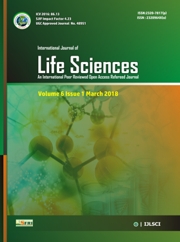ORIGINAL ARTICLE
Volume 9 |Issue 6| Novmber-December 2021 First published: 30 December 2021
Feeding Guild of Avifauna of Navegaon National Park, Maharashtra, India
Kedar GT*, Chinchkhede KH and Kaushik SA
Department of Zoology, Govt. of Maharashtra’s Ismail Yusuf College, Jogeshwari (e), Mumbai.400060.
Plot no. 42, Mahadulla, Post: Koradi, Tehsil: Kamptee, District: Nagpur, Maharashtra
Associate Prof. Address - Dept. of Zoology, Govt. Institute of Science, Nagpur -440001
Email: gtkedar@rediffmail.com
Abstract
Keywords:Avifauna, Navegaon National Park, Feeding Guilds., biochemical study, soil samples, PSM.
Editor: Dr.Arvind Chavhan
Cite this article as:
Kedar GT, Chinchkhede KH and Kaushik SA. Feeding Guild of Avifauna of Navegaon National Park, Maharashtra, India , Int. Res. Journal of Science & Engineering, 2021, Volume 9(6): 177-186.
References
1. Root R.B. The niche exploitation pattern of the Blue-Gray Gnatcatcher, Ecological Monographs,1967; 37, 317–350.
2. Ricklefs R.E. Evolutionary diversification, coevolution between populations and their antagonists, and the filling of niche space. Proceedings of the National Academy of Sciences USA,2010;1265–1272.
3. Aggarwal S., Sahi D. N. and Wani A.A. Feeding Guilds of Avifauna of Nandini Wildlife Sanctuary, Jammu (Jammu and Kashmir), The Ecoscan 2008; 2(2): 157-160.
4. Pandotra A. and Sahi D.N. Feeding Guilds of Avifauna of Gharana Wetland Reserve-Jammu (J&K), India. Interantional Research Journal of Environmental Sciences,2014; 3(4): 27-23.
5. Gray M A, Baldauf S L, Mayhew P J and Hill J K. The response of avian feeding guilds to tropical forest disturbance. Conservation Biology,2007; 21(1): 133–141.
6. MacNally, R .Habitat specific guild structure of forest birds in southeastern Australia: a regional scale perspective. Journal of Animal Ecology,1994; (63): 988-1001.
7. Gokula V & Vijayan L. Foraging pattern of birds during the breeding season in thorn forest of Mudumalai wildlife sanctuary, Tamil Nadu, South India. Tropical Ecology, 2000; 41(1)195-208.
8. Lawton, JH .Population abundances, geographic ranges and conservation. 1994 Whither Lecture. Bird Study,1996; 43 (3):19.
9. Johns A D. Responses of Amazonian rain forest birds to habitat modification. Journal of Tropical Ecology ,1991;7 (4):417–437.
10. Sheikh M. K. Ecological studies of Avifauna in the Naltar Valley, Northern Pakistan with a Conservation Perspective. (thesis). 2000.
11. Grimmett R., Inskipp C. and Inskipp T Pocket Guide to the Birds of the Indian Subcontinent. (2006) ;Oxford University Press.
12. Salim Ali. The book of Indian birds, Thirteenth Revised Edition, Bombay Natural HistorySociety Oxford University Press, Mumbai., 2002.
13. Salim Ali. The book of Indian birds, Twelveth Revised Edition, Bombay Natural History Society Oxford University Press, Mumbai.,1996.
14. Prajapati K.M., Patel M.I. & Acharya C.A. Guild classification for urban birds. The Asian Journal Science, 2008;3(1): 14-18.
15. Pearman P .B. The scale of community structure: Habitat variation and avian guilds in tropical forest understory. Ecological Monographs ,2002;72(1): 19–39.
16. Greenberg, R. The abundance and seasonality of forest canopy birds on Barro Colorado Island, Panama. Biotropica, , 1981; 13 (4): 241-251.
17. Stouffer, PC. and Bierregaard RO. Use of amazonian forest fragments by understory insectivorous birds. Ecology, 1995; 76 (8) : 2429-2445.
18. Rathod J., Deshkar S., Gavali D. and Sankhwal A. Birds of Coastal Jamnagar and their Feeding Guilds. Bulletin of Environment, Pharmacology and Life Sciences, 2015; 4 (10): 15-19.
19. Subramanya S and Radhamani T.R. Pollination by birds and bats. Curr Sci, 1993; (65): 201-209.
20. Zakaria M and Francis CM .The effect of logging on birds in tropical forest of Indo-Australia. The Cutting Edge: conserving wildlife in logged tropical forests. Columbia University Press, New York ,2001;193-212.
21. Martin T.E. and Karr J.R. Temporal dynamics of neotropical birds with special reference to frugivores in second-growth woods. Wilson Bulletin, 1986 ; 98( 1): 38-46
22. Blake J.G. and Hoppes .W.G. Influence of resource abundance on use of tree- fall gaps by birds in an isolated woodlot. Auk, 1986; 103( 2) :328-340.
23. Arshad M I, Zakaria M, Sajap A S and Ismail A. Food and feeding habits of red junglefowl. Pakistan Journal of Biological Sciences, 2000; 3(6): 1024–1026.
24. Nur Munira Azman.Nurul Salmi Abdul Latip,Shahrul Anuar Mohd Sah, Mohd Abdul Muin Md Akil, Nur Juliani Shafie and Nurul Liyana Khairuddi , Avian Diversity and Feeding Guilds in a Secondary Forest, an Oil Palm Plantation and a Paddy Field in Riparian Areas of the Kerian River Basin, Perak, Malaysia, Tropical Life Sciences Research, 2011;22(2): 45–64
25. Maeda T. Patterns of bird abundance and habitat use in rice fields of the Kanto Plain, central Japan. Ecological Research,2001; 16(3): 569–585.
26. Rajashekara S. and M. G. Venkatesha. Insectivorous bird communities of diverse agro-ecosystems in the Bengaluru region, India, Journal of Entomology and Zoology Studies ,2014;2(5): 142-155.

